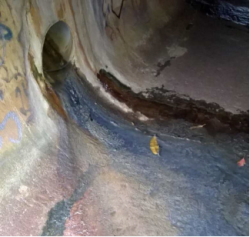
Search archive
Environmental Regulation in the US
29/06/2016

Last month, the Chair of AELERT, Tony Circelli, travelled to the United States to attend the Battelle Tenth International Conference on Remediation of Chlorinated and Recalcitrant Compounds.
Trichloroethene (TCE) soil gas vapour and ground water contaminants such as Perfluorinated Compounds (PFCs) are some of the most problematic and challenging legacy contaminants that environmental protection agencies are dealing with around the world.
Tony had the opportunity to hear from experts on new technical and regulatory approaches being considered as well as emerging chemical contaminants which, Tony notes, both Australia and the United States are beginning to get a better understanding of.
The conference included presentations regarding the ongoing controversial toxicology for soil vapour health effects, technological advances in measuring contaminants in real time, and a number of case studies about assessment, management and community engagement.
Key observations from these presentations included:
- Short term TCE standards are highly contested and result in significant social, economic, operational and legal complexities;
- PFAs are key emerging contaminants of interest in the USA;
- Australian agencies responding to PFA contamination would benefit from a consideration of the US response, at both Federal and State levels;
- Clu-In, maintained by the US EPA, is an excellent source for simple technical and strategic information on contaminated site remediation.
Members can find a selection of papers from past conferences here while papers presented at this year’s conference will be available on the website in due course.
After the conference Tony met with senior executives as well as a range of technical leaders at the US EPA headquarters in Washington DC and at regional offices in San Francisco (Region 9).
In Washington, Tony was briefed on topics such as the US EPA’s Superfund program, which is responsible for cleaning up some of the nation’s most contaminated land and responding to environmental emergencies, oil spills and natural disasters. To protect public health and the environment, the Superfund program focuses on making a visible and lasting difference in communities, ensuring that people can live and work in healthy, vibrant places. Tony noted the deliberate positioning of the US EPA as a public health agency and the ways in which EPA services (particularly in relation to air and drinking water quality) resonate at both the political and community level.
In Washington Tony also met with Jay Pendergrass, Senior Adviser to AELERT’s sister network, the International Network for Environmental Compliance and Enforcement (INECE) and Vice President for Programs and Publications at the Environmental Law Institute. The Environmental Law Institute works to foster innovative, just and practical law and policy solutions to enable leaders across borders and sectors to make environmental, economic and social progress. Jay discussed some of INECE’s key priority areas with Tony including strengthening compliance with requirements that restrict emissions contributing to climate change via INECE’s Climate Compliance Network; E-waste management and the Basel Action Network; and raising awareness of measures to control illegal logging and promoting compliance. Tony noted the strong links between the work being undertaken by INECE and AELERT’s Forestry Compliance and Enforcement Working Group.
In Region 9, which covers four States including California, Tony discussed the Region’s well-established statutory framework for cost recovery from responsible parties, ability to pay provisions, the use of ongoing management requirements and how they are governed in perpetuity. Tony also participated in discussions regarding the Region’s very proactive and structured approach to risk communications. Tony also met with members of the Environmental Council of the States (ECOS), Heads of the 50 State EPAs in the US, and the US equivalent of the Australian Heads of EPAs (HEPA) and was somewhat relieved to note the comparative ease of collaboration in Australia!

A complicated collaboration? On the office wall of the Environmental Council of the States.
ECOS advised that they have identified building capability and practice around risk communications as a key priority. Tony was pleased to learn of opportunities for collaboration between AELERT and the US EPA in this very significant practice area. Interested members can get in touch with AELERT’s Communications and Engagement Working Group to find out more.
Do you use surveillance? Then we need your input.
28/06/2016

You told us that you would like more information about operational issues that you face in your daily work. To that end, as we begin planning the AELERT 2017 Conference, we are considering the technology in use every day in our line of work and the technology we might need to use in the future.
To help us develop this area of interest we have created a survey seeking to determine the current surveillance technology in use across the membership, as well as gain feedback about possible future advances.
We would like to hear your feedback and would appreciate if you could give us five minutes of your time and participate in this very short survey.
If you don't use surveillance technology in your role but know of someone in your agency who does, we would love it if you would forward this survey link to them.
For more information, please contact the AELERT Secretariat at secretariat@aelert.net.
Sewer Leak Investigation Training Materials Available to Members
27/06/2016

In NSW, local councils are the appropriate regulatory authority under the Protection of the Environment Operations Act 1997 for non-scheduled activities, including sewage pollution from private sewer lines.
To assist councils in this, the NSW Environment Protection Authority and Sydney Water developed a sewer leak investigation training course with the assistance of a grant from the NSW Environmental Trust.
As part of this collaborative training project, a course participant manual and seven associated instructional videos were developed, intended to allow local council officers to:
- enhance the capacity of council officers to survey and investigate stormwater and receiving waters affected by sewer leaks;
- improve ability to respond to and resolve environmental issues and community complaints relating to sewer leaks;
- clarify the regulatory responsibilities around sewer leaks; and
- provide councils with reference material and support so they can better manage stormwater catchments.
This material is a useful reference resource for anyone involved in stormwater, wastewater and catchment management whether they have attended the training course or not.
DOWNLOAD HERE: Access to members only.
Anyone interested in attending the sewer leak investigation training course can register their interest at aelert@epa.nsw.gov.au
A vineyard that uses ducks instead of chemical pesticides.
21/06/2016

Indian Runners are an unusual breed of domestic duck.
They do not fly, they stand erect like penguins and, rather than waddling, they run. A vineyard in South Africa, Vergenoegd Wine Estate (near Stellenbosch) has put these birds to work.
The vineyard is home to 1,000 trained Indian Runner ducks that have the important job of keeping the vineyard free from snails and other pests minimising the use of chemicals.
This is not their only benefit as the droppings that the ducks leave on their journey through the grape vines also helps to fertilise the plants.
Denzil, the vineyards resident duck expert, explained: "The ducks sleep in an enclosed pen, and are herded out to the vineyards in the day, then for a swim in the dam, and then back to their pen in the late afternoon."
As the owners say on their website, "While dogs may be a man's best friend, here at the farm we believe that duck is a man's best assistant. One man's pest is another duck's snack."
“Here on the farm, we have a huge flock, which ranges from around 700 to around 900, depending on the time of year.
Denzil looks after them as if they were his own children and takes particularly dedicated care of our hatchlings, which he looks after in their own nursery.
Although "not the cheapest method of pest control", the owners firmly believe that using the ducks instead of pesticides "has tremendous advantages regarding conservation and the well-being of other animals."
"Plus," they add, "The quality of the wine is just so much better." Take a look at their website here.






What is the National Pollutant Inventory?
20/06/2016

The National Pollutant Inventory was Australia’s first national environmental protection measure.
Coming into effect on 27 February 1998, after extensive consultation across government, industry and community sectors, the NPIs impact statement was published and set out agreed national objectives for protecting or managing particular aspects of the environment.
The national environment protection goals established by this measure are to:
- collect a broad base of information on emissions and transfers of substances on the reporting list, and
- disseminate the information gathered to all sectors of the community in a useful, accessible and understandable form.
How is it useful for you?
Today, the NPI is a practical resource where industry, governments and the community can access information about reported substance emissions. A publically available internet database of air, land and water emissions of 93 substances and transfers of these NPI substances in waste, from industrial facilities and diffuse emission sources.
The seventeen years of data can be used for benchmarking, environmental management and policy development purposes.
Within EPAs, the information assists in cross-referencing submitted data and improving calculations for air and water quality modelling to better inform decision-making and policy development.
New data is now available for 2014/2015 detailing emissions from over 4,000 industry facilities.
Enhancements to the National Pollutant Inventory (NPI)
The Department of Sustainability, Environment, Water, Population and Communities is working in partnership with state and territory governments to improve the NPI. Changes will be implemented over the next 2–3 years.
Key features:
Coding the equations (or emission factors) from the NPI emission estimation technique manuals into calculators to improve data quality and make it simpler for industry to estimate their emissions. The calculators will be incorporated into a web-based reporting system for ease of data submission. Reducing the time taken to report will result in major cost savings to industry. Prototypes have been well received by industry representatives.
Building a web-based reporting system to simplify the process by which industry reports their emissions to the NPI, as well as provide improved validation. This, in turn, will feed into an enhanced jurisdictional database system allowing for more effective auditing of emissions data.
Updating emission estimation technique manuals progressively to reflect changes in emission factors, as well as industrial processes.
Redesigning the NPI website to improve the database search functionality, update fact sheets, and provide additional contextual data.
Varying the NPI National Environment Protection Measure (NEPM) to make the program more effective.
For more information rearding the enhancements email npi@environment.gov.au or phone 1800 657 945.
AELERT 2016 Membership Survey – the results
14/06/2016

Top-performing organisations understand that network engagement drives its business outcomes. Engaged members are more productive, more involved and more likely to participate. To that end, AELERT continues to strive to build on the feedback you provide in the AELERT Membership Survey.
Circulated to all AELERT members via the AELERT Newsletter, AELERT’s primary liaisons, the website and via social media, the 2016 AELERT Membership Survey produced some promising results with an adequate response rate being achieved.
Interacting with AELERT.
Of those who participated, over 86% of respondents indicated they had interacted directly with AELERT in the past year. A large proportion of this contact came from a member accessing an AELERT resource (57%), attending a face-to-face event (52%) and participating in an on-line discussion (26%). Additionally, high numbers were recorded for contact points with the Secretariat (33%), participation in training (22%) and contribution to a cluster (19%).
Overall the results for membership interaction with AELERT showed the website is the most frequently used resource and should continue to be fostered and promoted.
What you value about AELERT.
When members were asked to rank AELERT’s services in order of value, the results revealed the importance of effective two-way communication.
Respondents indicated they value training and skills development as their highest priority followed closely by conferences and e-newsletters. This highlights the significance of these services to members and confirms to the AELERT Steering Committee the importance of ensuring these services are continually developed and improved.
The 2016 AELERT membership survey showed that there is an extremely high level of support for the network with respondents revealing that 92% of their managers encourage their continued involvement in AELERT. Over 70% of respondents also indicated that they can spend 1- 5 hours a month working on AELERT-related activities.
The survey indicates members consider AELERT a valuable professional resource, with over 95% implying they were likely to recommend the network to other environmental regulators.
What you want to see more of.
Overwhelmingly, sharing experiences, networking and knowledge exchange were identified as AELERT’s most valuable services. Members commented:
“An opportunity to network with colleagues from other jurisdictions and learn from their experiences. It's also an opportunity get fresh ideas and spend time thinking about business improvement rather than just BAU.”
“Valuable for both sharing of experience and reinforcing/resourcing the struggle for a better level and quality of environmental regulation in Australia.”
The capability to access information regarding best practice regulation through AELERT was also noted to be beneficial to the members:
“It’s a great portal and repository for regulators to showcase their own products, outcomes, tips and professional advice.”
“The opportunity to engage with like-minded regulators. Updates on Compliance Tools and Professional Development resources.”
Members were asked to contribute to the future direction of the AELERT by offering their suggestions on how the network can improve its undertakings.
The majority of respondents indicated they were positive about AELERT’s activities, and they would like to see:
- Increased number of webinars
- Grow the website and its resources
- Additional state based activities
- Best-practice regulatory standards and the provision of legislative updates
- Invite regulators outside the environmental sphere to participate
Members also provided feedback regarding AELERT’s governance and strategic direction. The Steering Committee discussed this feedback at its last meeting in April and confirmed the importance on AELERT’s governance being executive-led in relation to securing the Network’s funding. The Steering Committee has also undertaken to hold an AGM-like event for members at the next AELERT Conference in Sydney in 2017. A forum to allow members to hear from the Steering Committee directly and to address any questions to them.
What can you do?
Clusters, or working groups, can accomplish great things. Much of your feedback has reflected your interest and requests to be active, more involved and achieve more effective outcomes.
But it is up to you. You need to be more involved. You need to participate and actively work with other team members to ensure a successful result.
A group's overall effectiveness hinges on the effectiveness of the participants' communication input. Lack of an active flow of information will directly influence the success of the group’s strategic goals.
To that end, the AELERT Steering Committee encourages the formation of working groups . Recommended suggestions proposed by members in response to the AELERT 2016 membership survey include:
- Fisheries and agriculture.
- Technology – to research, trial and promote innovative technological advances.
The committee agreed that chairs of the working groups created under the Operations Portfolio would need to collaborate and report back to the committee.
It’s up to you to get involved.
Steering Committee Meeting April 2016 Communique
14/06/2016

The 35th meeting of the AELERT Steering Committee was held in Melbourne, Victoria on Friday 8 April 2016.
Its focus, review of the 2016 Membership Survey, assessment of AELERT's events program and a cluster update.
This communique covers the outcomes from that meeting, including the following items:
- Welcome to AELERT’s first international members.
- Website update Confirmation of the themes for the upcoming webinars.
- Formation of a Technology and Surveillance work group.
- Approval for production of a video on “The Modern Regulator” presented by Neil Gunningham.
- Review of the 2016 Membership Survey.
Read the communique here.

